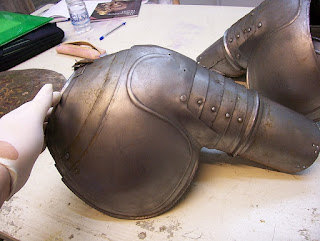The armour used by the Knights of St. John of Jerusalem in Malta gradually moved away from the personal armours which were brought by the members to a sort of uniform armour, "loaner armour" if you will. When the Grand Master demanded that any armour that came to Malta must stay in Malta even if the member was to leave the order, the supply of really pretty gold plated custom made armour suddenly dried up.
Since of course the order was made up of young gentry, fourth sons mainly who were forced into the church even though they preferred the excitement of tournament and the danger of battle, the Order was rather more attractive than so many other paths. At home they would just get into trouble, in Malta, the Grand Master would find a place and a use for them. So one could imagine some young tearaway arriving in Valetta with a dozen trunks of clothes, chests of wine, panopolies of armour and some spending money pressed upon him by indulgent aunts. The discovery that Jean deValette had forbidden women in the city would have been a great shock, amelorated by the martial tasks he would be put to straight away!
So the young fellow would learn from experienced knights, be kept out of the worst of the trouble that young scions can get into, kept away from his loser friends, and taught how to handle a galley, deal with slaves, meet Jews, Muslims, and various flavors of Christians, and learn to deal with multiple languages and princes (they were ALL princes) of what can only be described as a United Nations of the time. Sort of a residential finishing school for Chivalry.
When the young knight would be called back home because his older brothers had been taken out of the picture, the fancy armours stayed behind, and I suspect were probably turned into cash. Certainly there are very few of them left in the Palace Museum in Malta. (Though many were given away over the years by various governors) An armoury in Milan started making the armours, so there is a whole regiment of very plain, utilitarian Italian armours lining the corridors to the legislative assembly chambers. These were even more plain than usual, NEVER had a cod piece, were very roughly made to fit anybody. To the military eye (like mine), the armours have a very comforting "general issue" feel to them. Most have battle damage of some kind, all show their age. As GI as they were, they were all decorated, mobile, light, and did their job. After all, they WERE made for princes whose parents were often very wealthy. So the elaborate spadlers I have photographed here are what they wore during the "great seige" and later. Absolutely stunning, they look good, gleam in the sun in the approved fashion, the edges are roped (which puts them a little later than the great siege). Check out the gothic arch shape they make in the above picture. This arch was repeated in the elbows, knees and visor. And no doubt in the windows behind him.
The shouder is quite large...it actually uses more steel than the breastplate!
I personally love the little centre line notch, and the scribed decorative line a quarter inch back from the edge. One can almost imagine the armour maker wondering how to pretty it up on a budget. A problem which I have faced many times myself.
The lower cannons fit neatly into the elbow cops. This might even be an articulated elbow cop, but very simple floating cops were common as well. The cannon works perfectly even after all these years. Look at how much it has been battered, yet the lower cannon rotates smoothly through 360 degrees. I think the severe shaping required to form the sliding joint is so strong that most battle damage just glances off it.
From the inside, you can see how they rushed the job.
And the back gaps open for no reason that I can figure. Don't think I want that scissoring my gambeson back there.
The articulation is from slotted rivets. The random holes are from when the armour was mounted on an iron frame to be a statue. (brings tears to my eyes....)
The rough cut lames (clearly cut with a chisel) that you cannot see contrast sharply with the rolled and roped edgeswhich you can see. I found it kind of interesting that the person doing the roping did it totally by eye...the irregular spacing of the chisel marks is kind of neat.
The entire inside is a mass of huge hammer marks.
The above collection is of this same spadler from angles you don't normally see them at. And below is a picture of me, enjoying myself doing all those measurements.
And the question WILL arise...why do I call them Spadlers instead of Spaulders. The answer is simple....the Oxford English Dictionary calls them Spadlers, and there is NO entry for Spaulder. What do YOU make of that?















1 comment:
Awesome photos! Thanks so much for posting them!
About the spadlers, nice to know!
Post a Comment